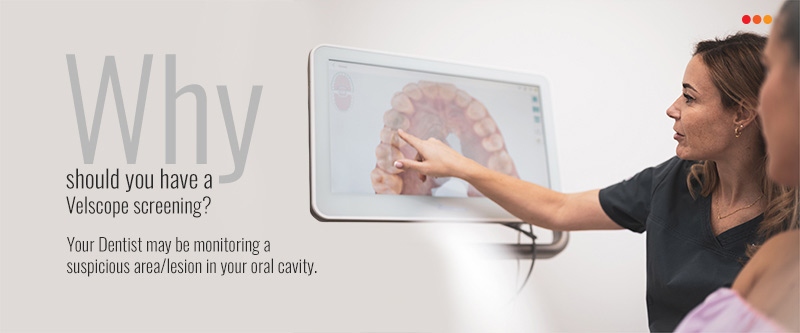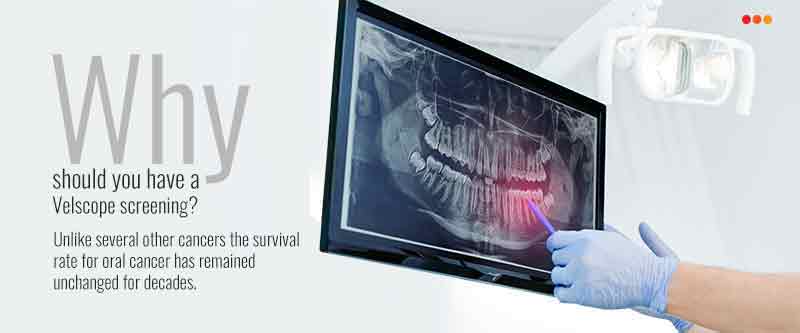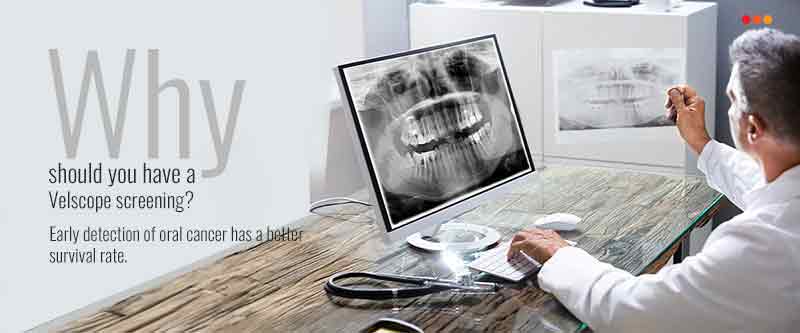Oral cancer and head and neck cancer are among the top 10 most prevalent types of cancer. Approximately 250 people in New Zealand are diagnosed with mouth cancer each year. While most instances will be effectively treated, oral cancer must be diagnosed early to increase the chances of success. Early detection is critical since oral cancer therapy can significantly impact someone's life. When patients are diagnosed with oral cancer in its later stages and receive therapy, their daily lives can become extremely challenging since oral cancer treatment affects how they talk, chew, swallow, and engage socially.
VELscope, also known as the VELscope Vx Enhanced Oral Assessment System, is a wireless handheld device that employs natural tissue fluorescence to improve our capacity to detect oral abnormalities that are typically invisible to the human eye. It is frequently utilized as an adjunctive tool for imaging tissue abnormalities in the mouth since it is convenient, easy to use, and employs basic and straightforward technology.
VELscope is a particular type of light to detect abnormalities, effectively used to see early forms of cancer or disease during an oral cancer screening. The VELscope, according to Gabriela Videira, MD of ISCS-Sul and Mário Arajo, RDH, BS, does not detect whether or not an oral lesion is malignant. Instead, the technology just aids in detecting anomalies that are not evident to the human eye.
Data Bridge Market Research analyses that the oral cancer treatment market, USD 1,805.8 million in 2022, would rise to USD 2,729.72 million by 2030 and is expected to undergo a CAGR of 5.30% during the forecast period 2023 to 2030. The oral cancer treatment market is segmented on the basis of type, therapy type, treatment, route of administration, end users, and distribution channel. North America dominates the market in the forecast to the rising affordability of drugs and the surge in the cases of oral cancer. Furthermore, growing awareness among the people in this region to cure dental caries and technological developments due to the presence of major market players lead to market growth.
To learn more about the study, visit: https://www.databridgemarketresearch.com/reports/global-oral-cancer-treatment-market
How Does VELscope Work?
Unlike traditional oral cancer screening, which includes visually inspecting the mouth for red, white, or black spots, VELscope employs a superior blue light to stimulate molecules deep inside the layer of our oral mucosal tissues, such as the mucous membrane lining the interior of the mouth. These energized molecules then emit their own light in green, yellow, and red wavelengths. The VELscope's unique filter enables fluorescence imaging by suppressing reflected blue light and increasing the contrast between normal and diseased tissue. Essentially, VELscope enables dentists to detect dysplastic cells or cells that are just starting to change into pre-cancerous cells via aberrant fluorescence patterns. A variety of factors can contribute to abnormal fluorescence patterns, including:
- Metabolic activity in epithelial tissue has increased
- The fluorescent collagen cross-links in the connective tissue layer underlying the basement membrane were broken down
- An increase in tissue blood content is caused by inflammation or angiogenesis because hemoglobin absorbs fluorescence excitation (blue light) strongly
- Melanin or amalgam particles that absorb light are present.
Oral abnormalities are not visible to the naked eye can now be discovered using VELscope. Furthermore, doctors may now determine the proper margins for surgical excision.
It only takes two or three minutes to complete the VELscope inspection. Every single year, many lives are saved because of this non-invasive, painless surgery. A quick description of a VELscope inspection is provided below:
The dentist will first conduct a standard visual examination of the entire lower face. Along with the teeth, this also refers to the glands, tongue, cheeks, and palate. After that, the mouth is rinsed with a pre-rinse solution for under a minute. The dentist gives patients protective eyewear to safeguard the retinas' structural integrity. To clearly see the oral cavity, the room's lights are decreased.
Oral Cancer and VELscope
The most frequent cause of mouth cancer growth is frequent smoking. Another element that has been linked to a higher risk of mouth cancer is alcohol consumption. On the other side, exposure to the sun may raise your risk of developing lip cancer. You can lower your risk of acquiring mouth cancer by giving up smoking, abstaining from alcohol, using lip balm and sunscreen every day, and quitting drinking.
You naturally have an increased risk of having mouth cancer if you are above forty. Oral cancer risk may also increase as a result of genetic factors. Men are twice as likely as women to have oral cancer. You must go to dental exams and screenings because none of these risk factors are under our control. The most frequent cause of mouth cancer growth is frequent smoking. Alcohol consumption can also raise your risk. Additionally, exposure to the sun may increase your risk of developing lip cancer. You can reduce your chance of mouth cancer by giving up smoking, abstaining from drinking, and using sunscreen.
Since it claims more lives each year than combined testicular, cervical, and brain cancer but receives less attention, oral cancer is frequently referred to as the "forgotten disease." Only 57% of the more than 30,000 Americans who develop oral cancer each year will survive for more than five years without treatment.
Many people think that if they don't use alcohol or tobacco, they won't get mouth cancer. Alcohol and tobacco use does increase the risk of oral cancer, yet 25% of people with the disease abstain from both. Getting annual oral cancer screenings is the greatest method to prevent mouth cancer. Most dentists examine for oral cancer as part of a routine dental examination. The FDA-approved VELscope gives dentists another exam tool to aid in the early detection of oral cancer. The VELscope is a blue excitation lamp that draws attention to alterations in malignant and pre-cancerous cells.
The Velscope System
Let's look at the VELscope itself to understand better how it functions. The VELscope depends on two essential parts: an eyepiece with an inbuilt optical filter and an LED ring that emits a specific wavelength of blue light. Clinicians can see areas that need more research by observing cellular and structural tissue changes while beaming light into the oral cavity and looking at the patient's oral mucosa through an optical filter. We now arrive at the concept of tissue fluorescence.
Tissue Reflectance VS Tissue Fluorescence
Utilizing the principle of tissue reflectance and conventional white light, doctors conduct oral examinations using traditional oral mucosal examination equipment. In contrast, the VELscope uses the idea of tissue fluorescence rather than reflectance. Fluorophores, which are chemical substances that respond to light excitation, are what produce tissue fluorescence. Fluorophores respond to the blue light of the VELscope by generating their own light at a longer wavelength, which can be seen through the VELscope eyepiece's optical filter. The VELscope can see the cellular change in the oral mucosa due to the fluorophores' stimulation, or lack thereof in some cases.
Fluorescence Patterns
The fluorophores in the oral mucosa's tissues normally respond to blue light when observed with the VELscope, as evidenced by the brilliant apple-green color of normal fluorescence patterns. Lymphoid clusters, the fungiform papillae on the tongue, and the extensively vascularized anterior tonsillar pillars are excellent illustrations of how normal fluorescence patterns can also reveal a lack of fluorescence. During a standard white-light reflectance assessment, sick mucosal regions may go unnoticed by the human eye, but abnormal fluorescence patterns enable clinicians to spot them. Normal causes of abnormal fluorescence patterns include:
- An increase in the epithelium's metabolic activity
- Fluorescent collagen cross-links in the connective tissue layer below the basement membrane are broken down
- An increase in tissue blood volume caused by angiogenesis or inflammation (hemoglobin absorbs fluorescence excitation light (blue) and emission light (green) very strongly)
- The presence of light-absorbing pigments, such as melanin or amalgam particles
Although the VELscope is frequently referred to as an instrument for screening for oral cancer, the idea of tissue fluorescence encompasses a wide range of oral abnormalities, enabling the VELscope to assist in visualizing a variety of oral health issues:
- Bacterial, fungi, and viral infections
- Several sources of inflammation, such as lichen planus and other lichenoid reactions
- Trauma
- Squamous papilloma's and salivary gland tumors are examples of oral cancer
- Tooth dysplasia
Data Bridge Market Research analyses that the North America oral care products and other dental consumables market will exhibit a CAGR of around 2.99% for the forecast period of 2021-2028. The growing prevalence of dental disorders, increased focus on research and development proficiencies in regards to medical devices and on the adoption of advanced healthcare technologies, ever-rising geriatric population and rising expenditure on the healthcare infrastructure development especially in the developing economies are the major factors attributable to the growth of oral care products and other dental consumables market. The North America oral care products and other dental consumables market is segmented on the basis of product type and distribution channel.
To learn more about the study, visit: https://www.databridgemarketresearch.com/reports/north-america-oral-care-products-other-dental-consumables-market
Conclusion
Инновационный ручной инструмент под названием VELscope предлагает гигиенистам и стоматологам простую в использовании дополнительную систему обследования слизистой оболочки для раннего выявления аберрантной ткани. Безвредный синий свет излучается в полость рта через наконечник VELscope, который возбуждает ткань и заставляет ее флуоресцировать от поверхности эпителия до базальной мембраны (где обычно начинаются предраковые изменения) и в строму ниже. Нормальная ткань обычно светится ярко-зеленым яблочным цветом, но отсутствие флуоресценции выделяет подозрительные области и, следовательно, кажется темным.
Согласно отчетам и клиническому опыту, технология VELscope полезна для дальнейшего анализа состояния здоровья полости рта. Клиницисты также утверждают, что внедрение технологии в стоматологию довольно просто, поскольку она может легко сфотографировать любые сомнительные места для возможной хирургической биопсии. VELscope была признана Департаментом основных медицинских технологий Всемирной организации здравоохранения как новая медицинская технология, которая решает глобальные проблемы здравоохранения и «вероятно, будет доступна, уместна и доступна по цене для использования в странах с низким и средним уровнем дохода». Это показывает, что VELscope является необходимым инструментом для улучшения здоровья полости рта экономически эффективным и удобным для пользователя способом.
Флуоресцентная визуализация (FV) используется в инновационном новом методе VELscope. По сути, аномалии и поражения, которые обычно не видны невооруженным глазом, выявляются во рту путем освещения его интенсивным синим светом. Тот факт, что симптомы рака полости рта могут быть ошибочно приняты за симптомы менее серьезных заболеваний, делает диагностику заболевания одной из самых сложных задач. Система VELscope дает стоматологу ценную информацию о том, что происходит под поверхностью.
Здоровая мягкая ткань рта естественным образом поглощает частоту синего света VELscope. Здоровая мягкая ткань под кожей выглядит зеленой, а проблемные области становятся намного темнее. Ниже приведены некоторые преимущества использования системы VELscope:
- Возможно сочетание с цифровой фотографией.
- Обнаруживает белые и красные пятна, а также поражения
- Обнаруживает проблемные места, невидимые в белом свете
- Обнажает злокачественные и предраковые ткани
- Одобрено FDA
- Помогает стоматологам убедиться, что все нездоровые мягкие ткани удалены.
- Увеличивает шансы на выживание, помогая в ранней диагностике рака полости рта
- Быстрые и безболезненные проверки
Глобальный рынок косметической стоматологии оценивался в 23,45 млрд долларов США в 2021 году и, как ожидается, достигнет 40,60 млрд долларов США к 2029 году, регистрируя среднегодовой темп роста в 7,10% в прогнозируемый период 2022-2029 годов. «Стоматологические больницы и клиники» составляют крупнейший сегмент конечных пользователей на рынке косметической стоматологии в прогнозируемый период, поскольку они предоставляют признанных правительством стоматологов. Отчет о рынке, подготовленный командой Data Bridge Market Research, включает в себя углубленный экспертный анализ, эпидемиологию пациентов, анализ конвейера, анализ цен и нормативную базу. Рынок косметической стоматологии сегментирован на основе продукта, возрастной группы и конечного пользователя.
Чтобы узнать больше об исследовании, посетите: https://www.databridgemarketresearch.com/reports/global-cosmetic-dentistry-market













